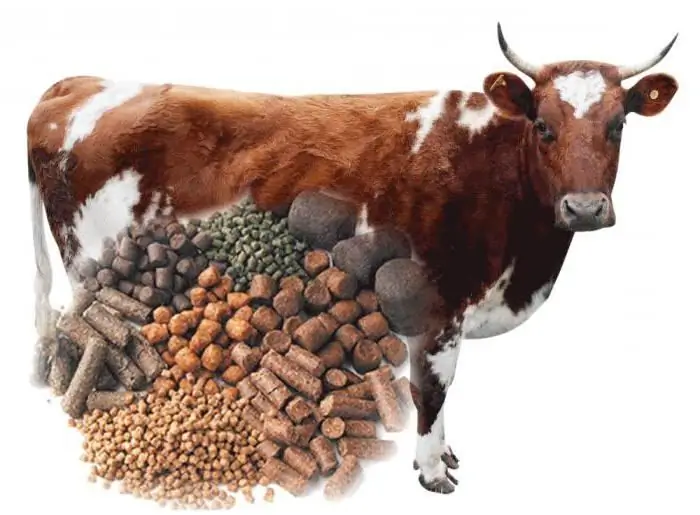2026 Author: Howard Calhoun | [email protected]. Last modified: 2025-01-24 13:10:28
Feed yeast is used in the production of such an indispensable product for agriculture as compound feed. They are included in the diet of domestic animals and poultry and in their pure form. In the latter case, they are usually used as a dietary supplement.
From what and how they are made
Fodder yeast is produced from ordinary, technically pure yeast. The production is based on the cultivation of microorganisms in a specially created nutrient medium, which consists mainly of monosaccharides. The latter include mannose, glucose, galactose, xylose, arabinose. The second important component is acetic acid. It and monosaccharides are obtained by hydrolysis of polysaccharides, contained in large quantities in the cell walls of various kinds of vegetable waste.
In addition to these two substances, the nutrient medium also contains urea and phosphoric acid. In small quantities, it also contains calcium, sulfur, iron, manganese.

From the outside, fodder yeast, the production of which is a rather technically complicated process, representsa light or dark brown powder, with a characteristic odor.
Main cast
The composition of the dry matter of fodder yeast includes the following substances:
| Component | Percentage ratio |
| Protein (according to Barnstein) | 32-38 |
| Ash | 10 |
| Protein | 38-51 |
| Fiber | 1.2-2.9 |
| Fat | 2.2-3.1 |
| Dietary fiber | 1.8 |
Feed yeast, whose production is currently based on modern technologies, will significantly increase the profitability of any farm. Above is the composition of the product grown on distillery stillage. The percentage of these substances in the additive on a different basis may be different. In terms of protein, one ton of fodder yeast is comparable to 4.5 tons of wheat, 4.6 tons of oats and 3.5 tons of corn.

Of course, when growing this additive, all the prescribed GOST standards are observed. Feed yeast today is an inexpensive and high-quality product.
Why you should use feed yeast
The value of this dietary supplement is primarily that it is an important source of protein and protein. As for the first, there is currently a shortage in feed in our country. Exactlydue to a lack of protein, the digestibility of food by animals and their ability to reproduce are deteriorating. In addition, the quality and quantity of products are declining.

When added to animal food, yeast increases its biological value. In addition, such food is much better absorbed by cows, horses, chickens, etc. Among other things, fodder yeast contains just a huge amount of vitamins, as well as useful micro and macro elements. This supplement also contains enzymes that help improve the metabolism in the body of animals.
In those farms where fodder yeast is used, the cost of basic feed is reduced by 11-15 units. products. At the same time, the productivity of animals increases - the number of milk yields, eggs laid, etc. In addition, an increase in their live weight (up to 30%) is observed. Animals improve their reproductive abilities, and eggs, meat and milk become tastier. In all products, the cholesterol content drops significantly.
How to use: general rules
You can use fodder yeast as a food additive for absolutely all types of poultry and animals. Their use in any case will significantly increase the profitability of production. Below is a table from which you can find out the recommended percentage of this product in feed for different groups of animals.
| Laying hens | 7% |
| Boilers | 7% |
| Cattle | 5% |
| Pigs | 10% |
If fodder yeast is used correctly, from one ton of them you can get an additional 400-600 kg of pork meat, 1500 kg of chicken, 8400 liters of milk, 15,000-30,000 eggs.

Fodder yeast: application for laying hens
The maximum effect from the use of fodder yeast can be obtained if the bird is grown on a corn-sunflower diet. It is very useful to feed this product, including laying hens of the parent flock. Its use allows to increase the degree of fertilization of eggs and hatchability of chickens by 10-15%. The fact is that yeast ensures the accumulation of vitamins in the yolk of the egg, and also normalizes the development of the embryo. Among other things, as a result of feeding this supplement, the mass of laid eggs increases. Of course, in this case, they have a very good presentation and are sold much better.

Use for ducks and geese
Feed yeast is the most effective means of increasing the incubation properties of waterfowl. In order to increase the yield of young animals, this supplement is given to producers 2 weeks before oviposition in the amount of 9% by weight of the feed. This is about 10-15 g per duck or 20 g per goose. It is advisable to continue feeding feed yeast throughout the laying period.
Feeding this supplement to young animals raised for meat, among other things, slows down the formation of fat and stimulates the intensive development of muscle tissue. In order to grow a bird with such dietary meat, 10-20 g of fodder yeast per head per day should be included in its diet. It also greatly increases the profitability of a farm or backyard.
Use for pigs
Fodder yeast, the use of which is justified in most cases, can be used, for example, to increase the reproductive capacity of animals. Feeding just 7% of this supplement (by weight of compound feed) allows you to increase the prolificacy of sows in the amount of one additional piglet for every 11 births. Be sure to give this product to lactating animals. Feed yeast, among other things, stimulates the lactation process. And this means that newborns will gain weight much faster.

Of course, fodder yeast, the price of which, by the way, is low (from 7.5 thousand rubles per 1 ton), can also be given to small pigs. In the case of using 10% yeast, the increase in animal weight gain will reach 8-17%. Also, feeding this supplement helps to improve the he alth of piglets and virtually eliminates all sorts of metabolic disorders. It is very good to use fodder yeast for primary feeding. The initial dose in this case should be about 10-15 g per day per head. You can start using this supplement from the second decade of life of piglets.
Cow Application
How to use feed yeast for pigs, we found out. Now let's see how useful this supplement is for cattle and how to use it. In this case, feed yeast is usually given to high-dairy cows (milk yield - over 20 liters per day) at a milking rate of 500-800 g per day in the first forty days.
Dairy animals are fed this supplement simultaneously with silage or starch waste. Among other things, fodder yeast protects the stomach and intestines of the animal from the negative effects of acids. Also, this product is able to normalize the development of the fetus in pregnant cows. Using fodder yeast, you can increase milk yield by 1-2 kg per day. One animal should have about 600-1000 g per day.
As you can see, using such a wonderful product as fodder yeast is a must. This will allow you to get more meat and eggs, including when breeding poultry on a personal plot. In large farms, however, this additive can be truly indispensable, since its use helps to reduce feed costs and significantly increase productivity.
Recommended:
Mixed feed: types, composition, application

The indisputable fact is that for the full growth and development of farm animals and birds, the basis of the diet should be combined feed (mixed feed). It should be noted that several feed recipes have been developed for each type of domestic animal. We will talk about types in our article
Forage wheat grade 5. Feed for farm animals. feed grain

Feed grains are cereals intended for feeding farm animals. Forage is the basis of diets in poultry and pig breeding, as well as a valuable component in cattle breeding. Such crops cannot be used for food purposes
Modern production. The structure of modern production. Problems of modern production

Developed industry and a high level of the country's economy are key factors influencing the we alth and well-being of its population. Such a state has great economic opportunities and potential. A significant component of the economy of many countries is the production
Gas production. Gas production methods. Gas production in Russia

Natural gas is formed by mixing various gases in the earth's crust. In most cases, the depth of occurrence ranges from several hundred meters to a couple of kilometers. It is worth noting that gas can form at high temperatures and pressures. In this case, there is no access of oxygen to the place. To date, gas production has been implemented in several ways, each of which we will consider in this article. But let's talk about everything in order
How to feed horses: types of feed, nutritional rules and diet

To figure out what to feed horses, it would not hurt to find out how these animals eat in the wild. In ancient times, herds of horses simply grazed in the meadows. This was enough to provide their body with all the necessary nutrients

